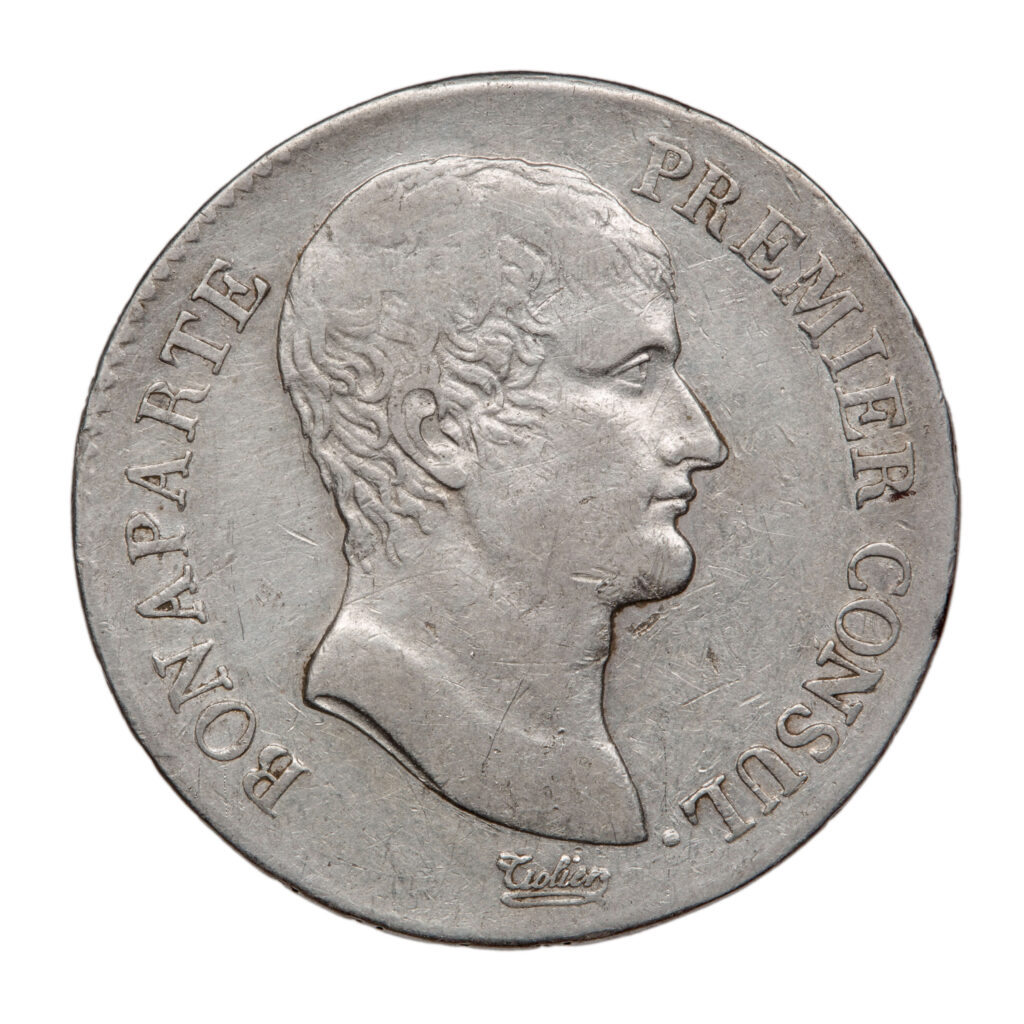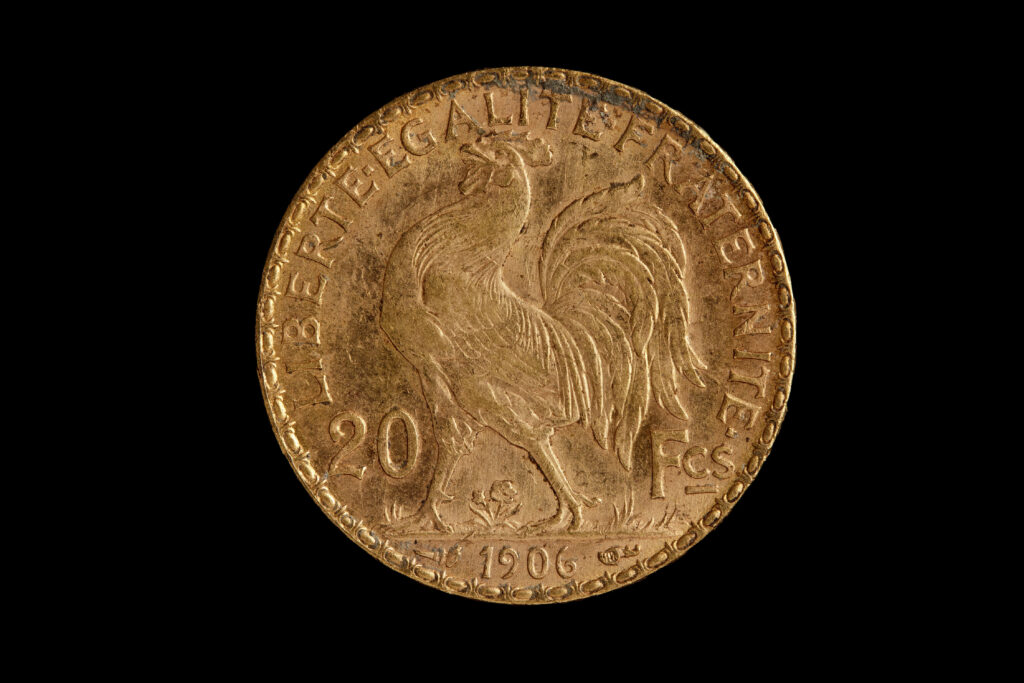The Musée Dobrée – Grand Patrimoine de Loire-Atlantique is exhibiting for the first time, the ensemble of its monetary treasures discovered in the department over the past century and a half. The exhibition takes place until 29 September 2019. Admission is free.
This remarkable archaeological heritage reveals the history of the département from the time of the Gauls to the start of the 20th century, the region’s commercial relations, and its political and military activity. Over six thousand items, discovered in almost fifty towns or municipalities in Loire-Atlantique, are presented and explained here.
This exhibition is also the opportunity to discover the careers and expertise necessary to the study and understanding of monetary treasures: archaeologists, restorers and numismatists.

In the days before money – The appearance of money… (circa 1600-500 BC)
In the Bronze Age, Armorica (the part of Gaul between the Seine and the Gironde) was a large producer of axes. The form of these axes shared certain features. Although they had no utilitarian function – they did not cut – they were collected and hidden in repositories, oftentimes in large quantities. Several characteristics allow us to believe that they were used as a form of currency.
Their geographical dispersion gives the impression that they were used as a means of payment during commercial exchanges. Their varying sizes allow us to imagine that several different values existed. The variety of their geometric motifs (lines, dots, circles) evoke tribal distinguishing marks. According to these elements, seven main varieties have been identified for these so-called ‘socketed’ axes, mainly produced from 1,000 BC onwards. These varieties allow us to classify them according to the site of their fabrication (Tréhou, Brandivy, etc.).
Neither weapon, nor arm, but very present throughout the region, bronze axes may be considered the precursors to a form of currency.

Antique treasures – From the Gaulish stater to Roman coins (circa 200 BC to AD 450)
Money or currency appeared in Armorica in the 4th century BC thanks to the Gaulish mercenaries who brought back gold coins (staters) from Greece, depicting Philip II of Macedon (382-336 BC). The Armoricans reproduced the Macedonian currency but introduced their own iconographic elements, such as a horse with a human head. As the quality of the gold gradually deteriorated, silver coins became more commonplace before the Roman conquest of Gaul (50 BC).
After the conquest, the Gauls used only Imperial Roman coins. In the 3rd century, the Empire was torn apart. The currencies then in circulation in Armorica were minted by the Roman Emperor or by his adversary the Gallo-Roman emperor. These included antoninians: small copper coins covered in silver. In remote areas of the Roman Empire, the inadequate availability of money added to the political crisis. To remedy this, local authorities organized the minting of ‘complementary currencies’. Long considered ‘barbaric imitations’ because of their poor execution, these were the product of relatively unknown local workshops.

Medieval treasures – Gold, silver… then, gold, silver and copper! (circa 500 to 1500)
The Middle Ages began with the Merovingian period (from the 5th to the 8th century), characterized by the minting of gold coins exclusively in many small workshops. In Loire-Atlantique, for example, coins were minted in Nantes, Rezé, Port-Saint-Père, Déas (Saint-Philbert-de-Grandlieu), Campbon, Besné and Béré (Châteaubriant).
From the 7th to the 13th century, silver completely replaced gold and minting took place mainly in the major cities. In our region, only Rennes and Nantes minted silver coins (deniers).
In 1265, the Saint Louis Reform lastingly affected the monetary organization of the kingdom of France. In addition to deniers in billon (made from a silver and copper alloy), the king minted the first gold écu d’or and silver gros d’argent, with a high monetary value. These divisions were more practical for trade.
Although the king held the monopoly on the minting of coins, lords were gradually allowed to mint these high-value currencies. Taking advantage of the disorganization of royal power due to the Hundred Years War (1337-1453), the dukes of Brittany minted their first silver and gold coins in the 14th century.

Post-Revolutionary treasures – The first francs (circa 1800 to 1900)
In 1795, the Convention (1792-1795) defined the franc as the new monetary unit which was divided into 100 centimes.
However, it wasn’t until the Consulate (1799-1804), and the law of 27 March 1803 (7 Germinal Year XI in the Revolutionary Calendar) that the co-existence with the monetary system inherited from the royal period came to an end. This law, known as the ‘Franc Germinal’, would govern French monetary structure for 120 years. It was applied to all successive political regimes, including revolutions, and was only abandoned after the First World War and the serious economic crisis that followed.
The system was based on a gold / silver ratio of 15.5 grams of silver per 1 gram of gold.
The ‘Napoleon’ was the gold coin, with a monetary value of 20 francs. The franc was a 5-gram silver coin, and the centime a 1-gram copper coin.
From 1865 onwards, this monetary system was extended to Belgium, Switzerland and Italy, then to Spain and Greece in 1868, and later to other countries. The monetary borders gradually fell and the ‘Latin Monetary Union’ continued until 1927.

Legends and tales of treasure – The treasure of the korrigans of Guérande
According to legend, the korrigans (small fairies) on the Guérande coast had a cave in the cliff near Trégaté, where they stored the treasures they had amassed by plundering shipwrecks. A sea fairy provided the korrigans with guidance and counsel, and disguised as a beggar, tested the goodness of men. One day, she suggested to a kindly salt-maker that he steal the korrigans’ treasure and for this, she provided him with a magic key and a ring of invisibility. At nightfall, the salt-maker succeeded in stealing a bag of gold and diamonds, and hid his bounty under a stone. However, overcome by greed, the salt-maker returned to the cave at sunrise in search of more treasures but the magical objects given to him by the fairy as a form of protection had now lost their power. The salt-maker found himself a prisoner of the korrigans. The korrigan chief ordered him to be smothered under a pile of gold, as a punishment for his acts of thieving. It was at this very moment that the sea fairy re-appeared. She scolded the salt-maker for his greed and took back the magical items. She saved him from the korrigans and in exchange for the salt-maker’s kind nature, despite his display of greed, she offered him a tin platter, which was garnished three times a day, with all kinds of dishes.
Excerpt from Patrick Denieul and Pascal Moguérou, Les mari morgans et autres legends de la mer.
You can find more information about the exhibition at the museum’s web site.
In 2018, CoinsWeekly published an article about the Musée Dobrée theft.
If you visit the museum, stop by the Île de Nantes to see the Great Elephant:




